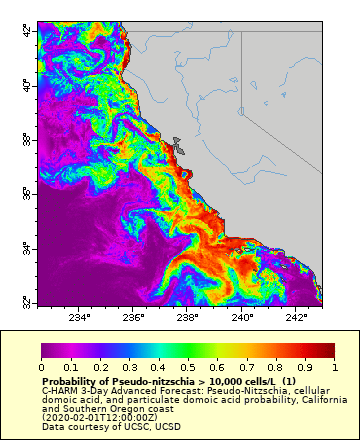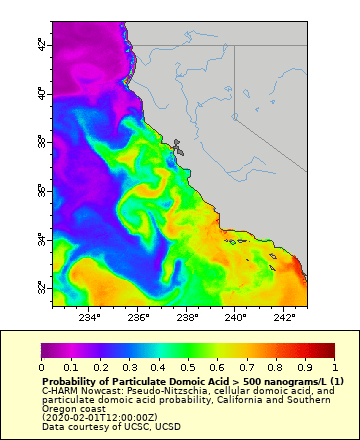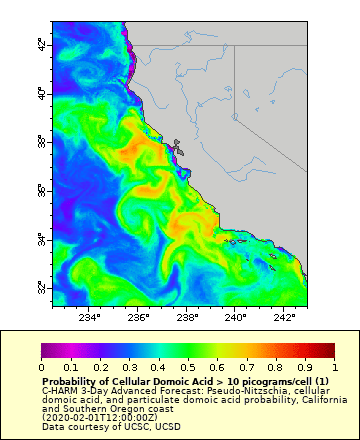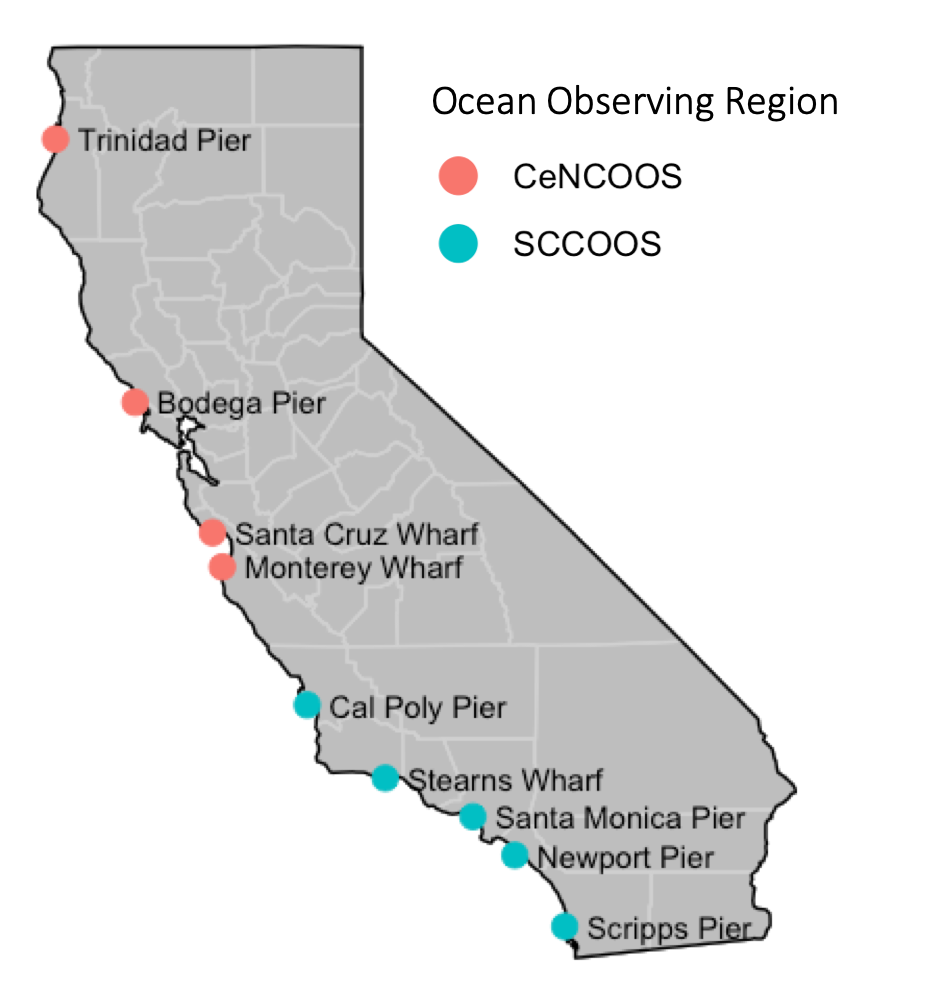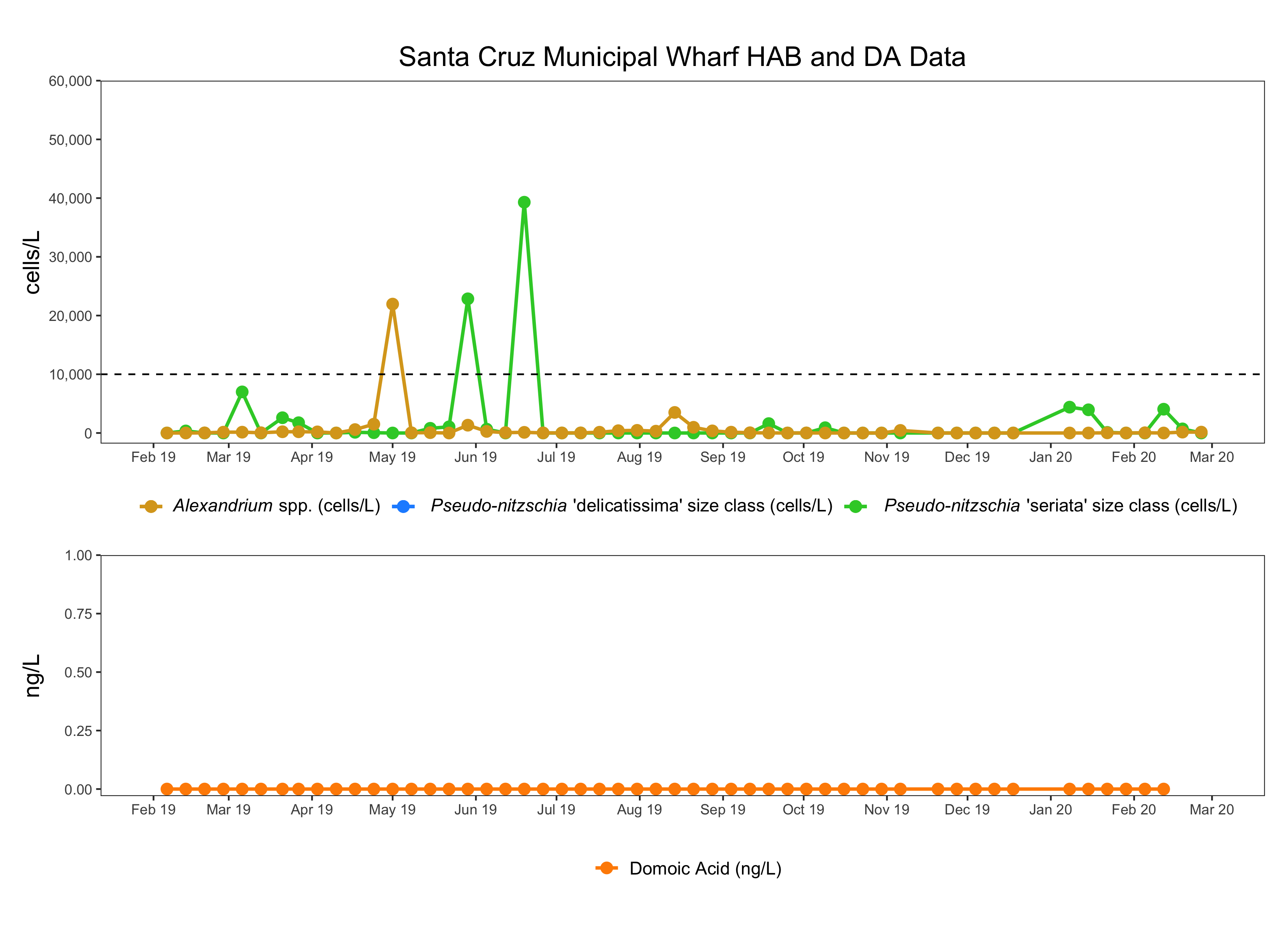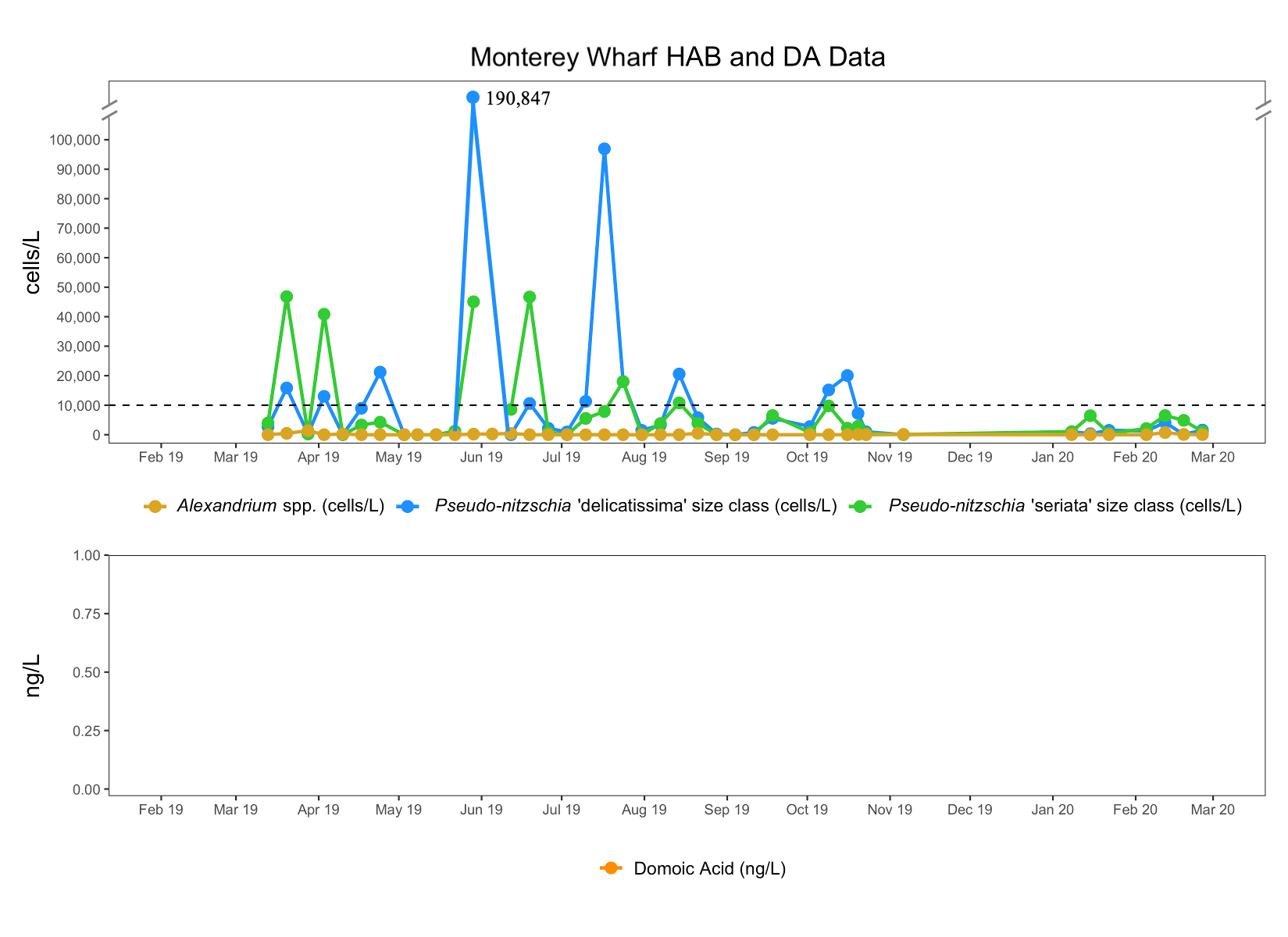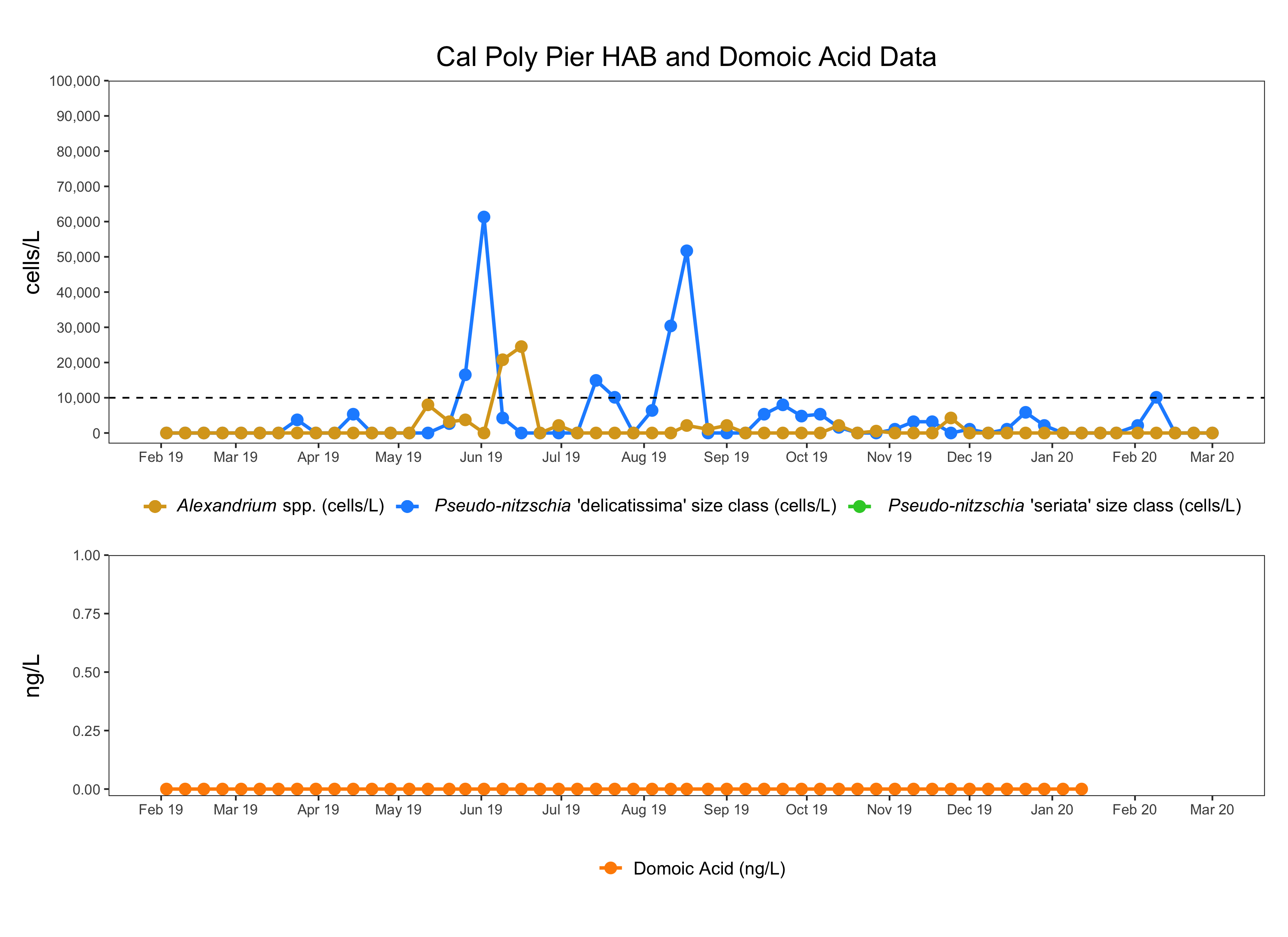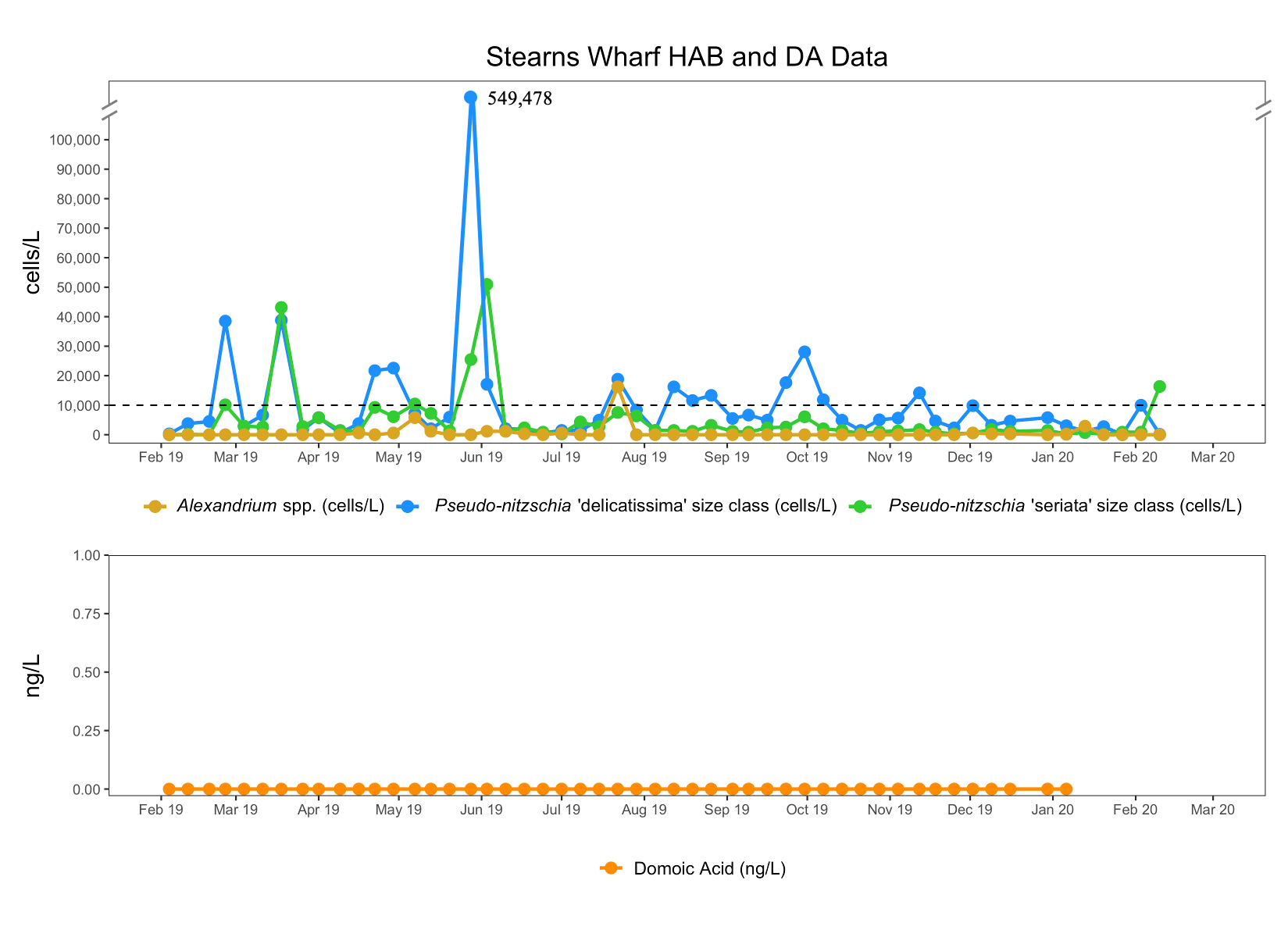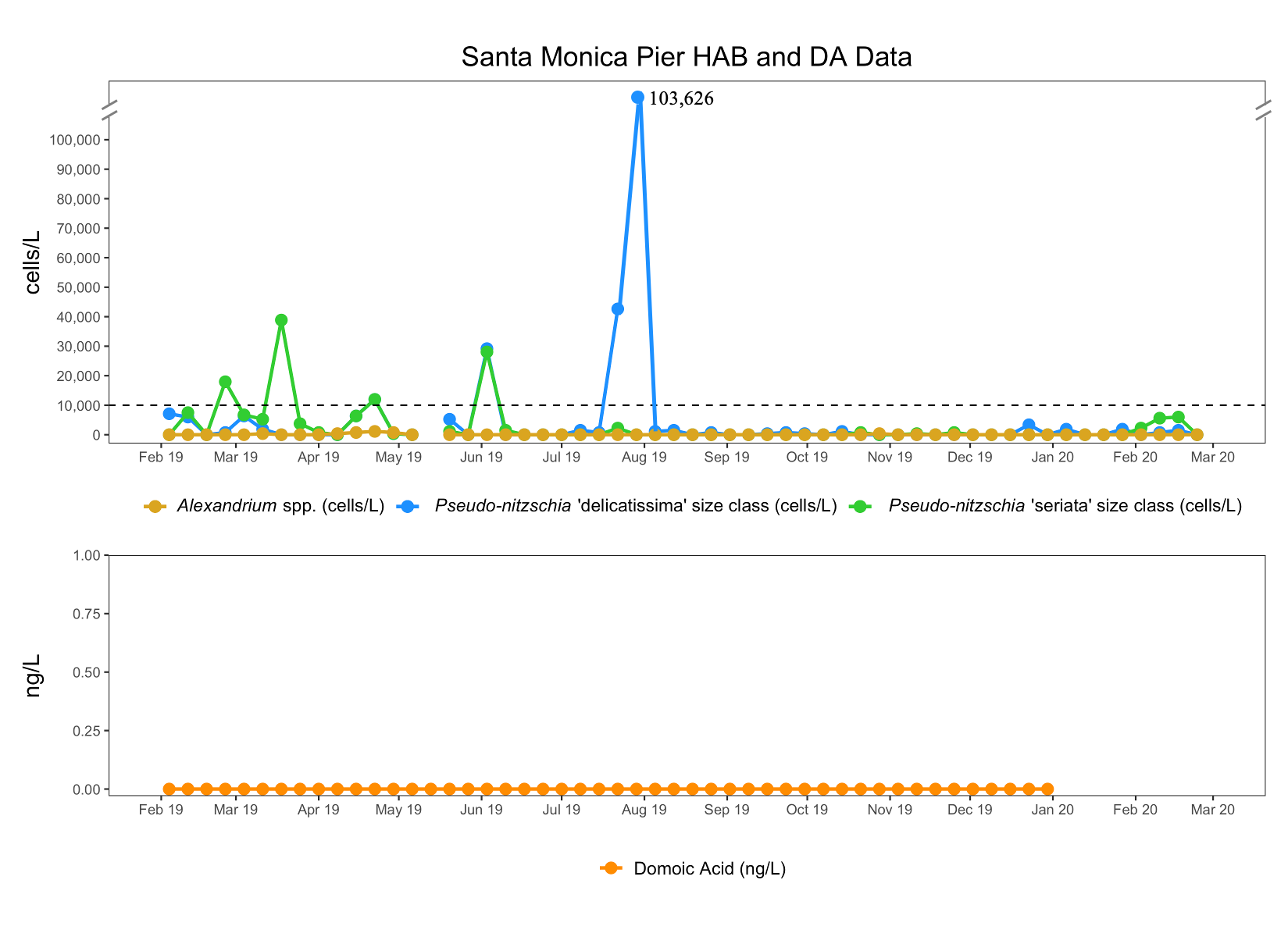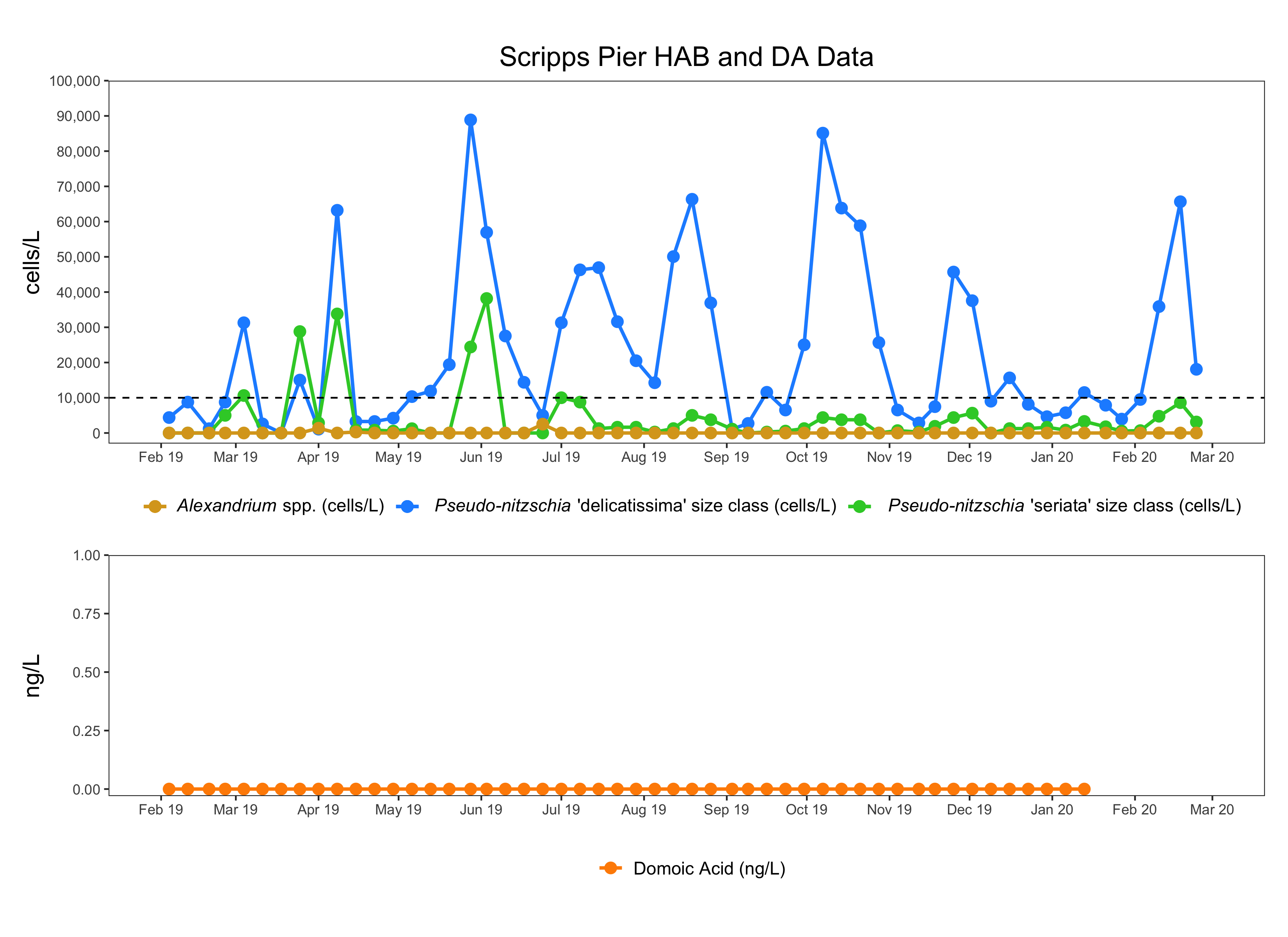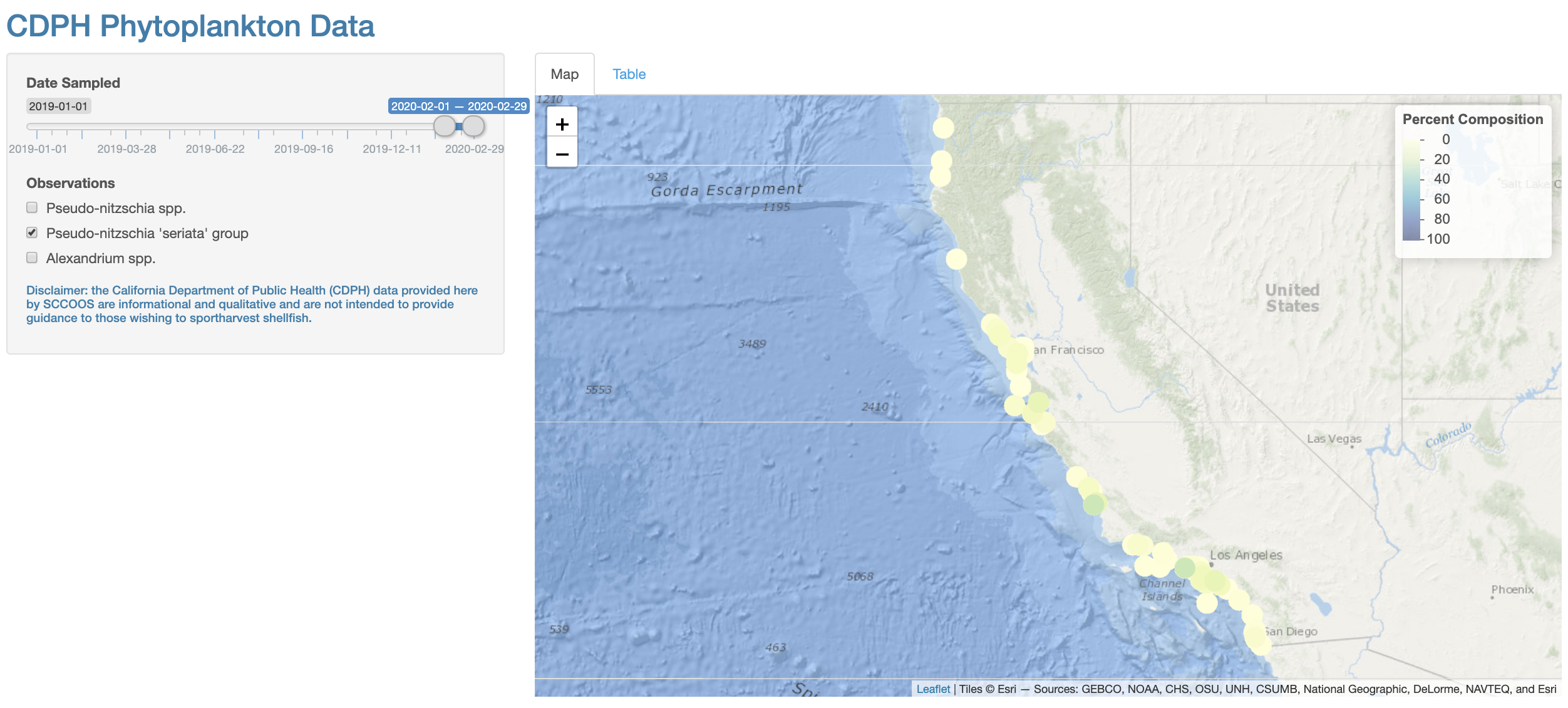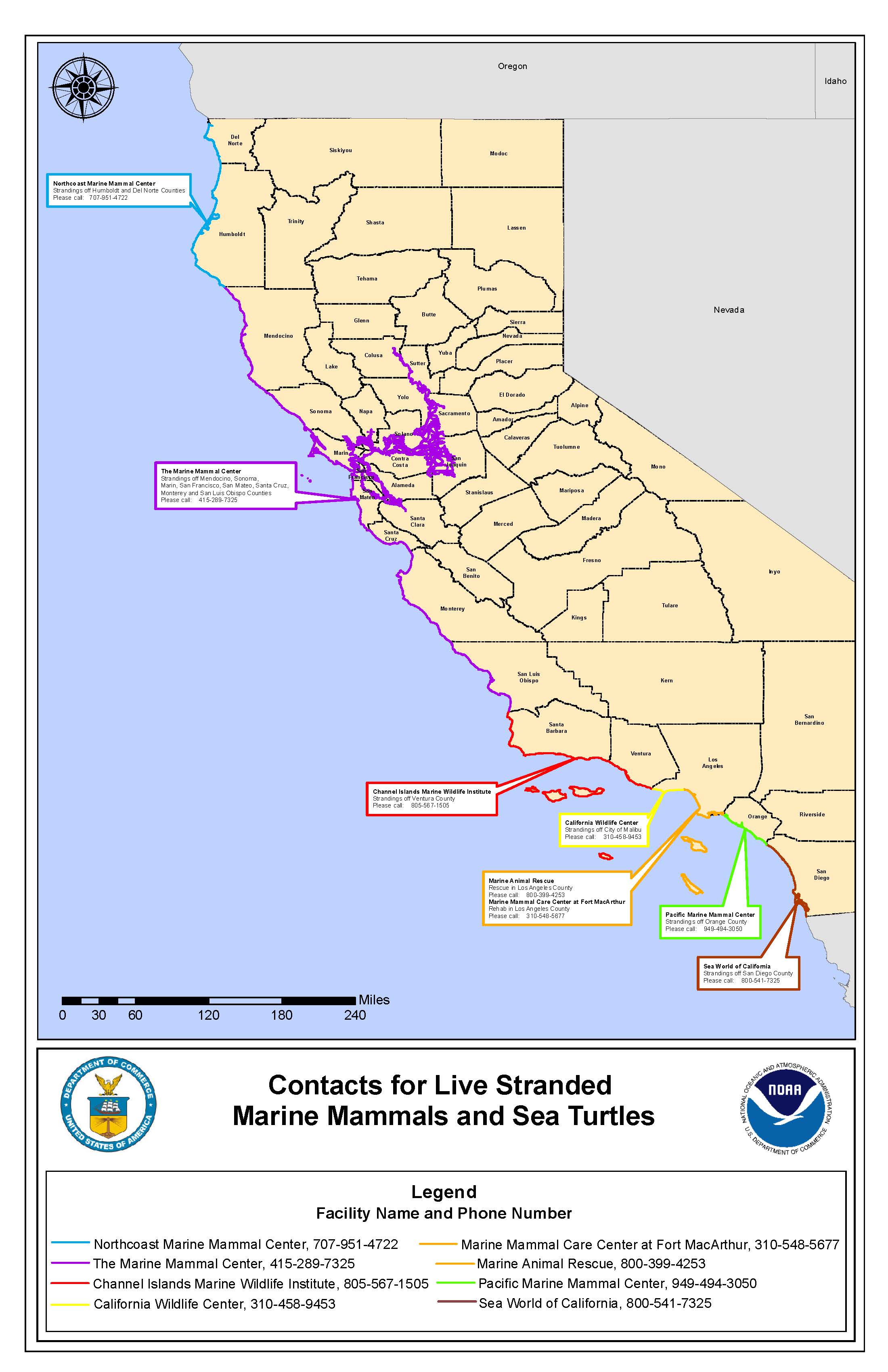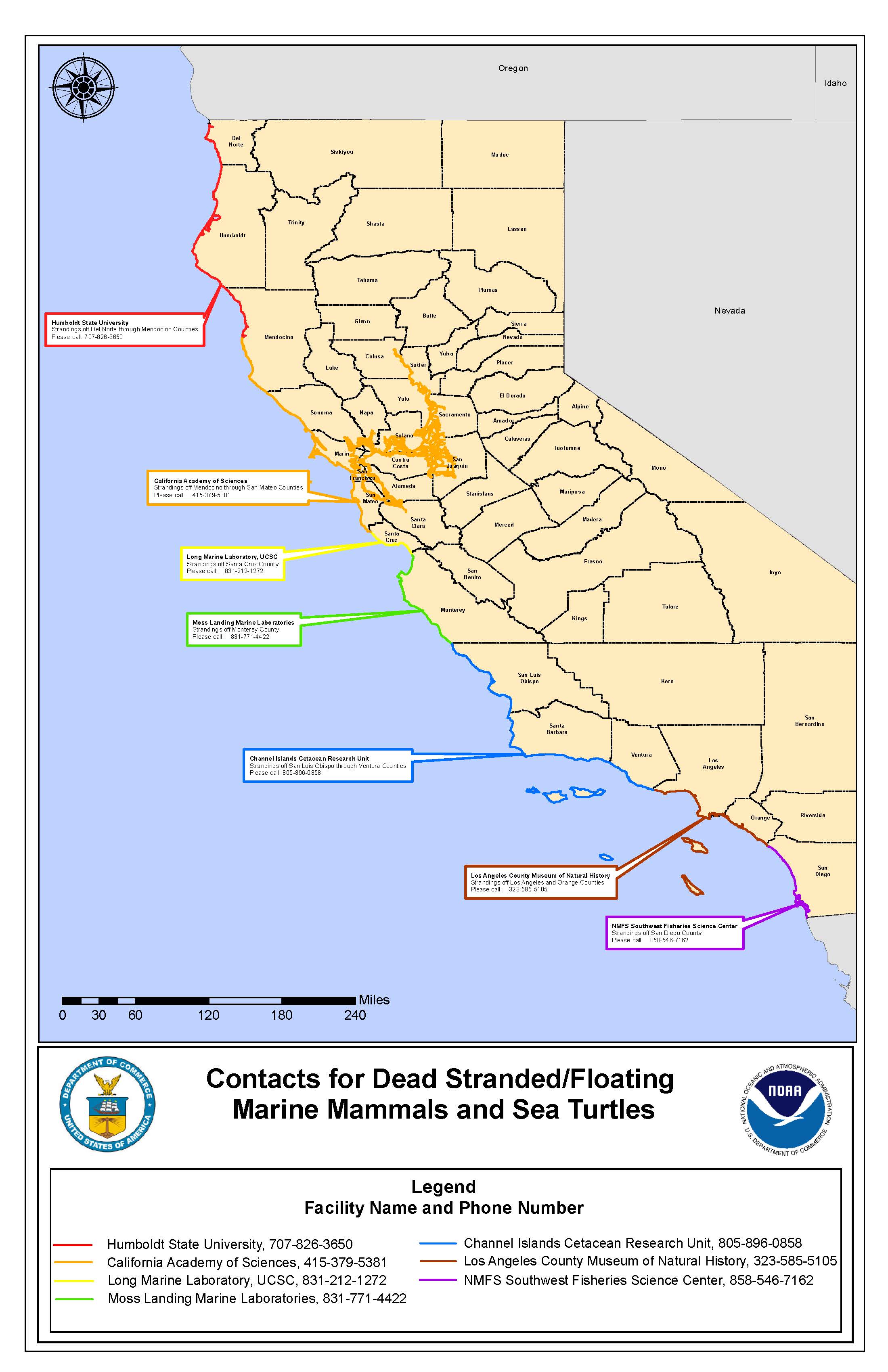Pseudo-nitzschia - C-HARM tells us where conditions are suitable for species of the diatom Pseudo-nitzschia spp. (all size classes) to grow well and where they might be more likely to produce domoic acid (DA). Predicted suitable habitat for Pseudo-nitzschia spp. was spread around throughout coastal California in February, much like in previous months, although C-HARM output was not available after Feb 21. A robust crop of Pseudo-nitzschia biomass was predicted for the north coast, more strongly and consistently than in January. High bloom probabilities were predicted for Marin/Sonoma Counties throughout most of the month. Other Pseudo-nitzschia bloom hot spots were more consistent from January to February, namely most of the coast north of the Santa Barbara Channel and narrow bands of high bloom probability in the Southern California Bight. C-HARM predicted periods of high probabilities of particulate DA (pDA) in central CA, throughout the Santa Barbara Channel, and the Southern California Bight. These high probabilities were spatially and temporally patchy, with the most consistently high probability regions being those around Pt. Conception and, earlier in the month, nearshore sections of Orange and San Diego Counties. North of Monterey Bay, the regions close to the coast near SF Bay, Marin, Sonoma, and Humboldt counties experienced consistently high pDA probabilities throughout February. Notably, the offshore region along the north coast had very low (near zero) probabilities of developing a pDA event. C-HARM highlighted the central coast and northern coast up to Humboldt as consistently likely regions for high cellular DA (cDA) levels, unlike in January when probabilities for cDA were notably low for those counties (and their offshore coastal regions) north of Sonoma. Some patches of high cDA probability blipped on and off during February in a nearshore swath around Orange and San Diego Counties.
There were six sea lion strandings from suspected DA toxicosis in the Los Angeles County area, and five occurred between February 10th and 15th. The strandings are consistent with C-HARM predictions of high probabilities for pDA and cDA in the LA area in January and somewhat in February. It should be noted, however, that DA probabilities in February were higher for Orange and San Diego Counties than LA, but the Pacific Marine Mammal Center in Orange County did not record any mammal strandings from DA toxicosis. SeaWorld in San Diego, on the other hand, did record one adult Pacific Loon that stranded on February 22nd in Point Loma suffering from ataxia and seizures. Interestingly, the Marine Mammal Center in Sausalito did not record any central CA strandings from DA toxicosis, consistent with suppressed probabilities of high DA events in the Monterey Bay and SF Bay areas but inconsistent with the high DA predicted for Marin/Sonoma Counties.
In comparison with the Harmful Algal Bloom Monitoring and Alert Program (HABMAP) measurements where we have February data currently available, the only sites with bloom levels of Pseudo-nitzscha (i.e. 10,000 cells/L or more) were at Stearns Wharf (Santa Barbara) and Newport Beach Pier (Orange County), and for both sites, this was the larger, more toxigenic "seriata" size class of Pseudo-nitzschia. This is consistent with C-HARM in that these piers lie within zones of high Pseudo-nitzschia bloom and DA event probability. Piers within other regions highlighted by C-HARM as more consistent hot spots, however, did not experience bloom-level Pseudo-nitzschia spp. abundances. Pseudo-nitzschia spp. were detected below bloom levels at all other pier sites, although close to the 10,000 cells/L bloom threshold at some sites for either size class. DA data were only available in February for Santa Cruz Wharf, and none was detected.
CDPH recorded their highest relative abundances of Pseudo-nitzschia "seriata" size near Pt. Dume (LA County) with Long Beach and Santa Cruz Wharf being two other spots of low but present Pseudo-nitzschia. This is somewhat consistent with HABMAP measurements in that bloom levels were detected at Newport Beach Pier (Orange County) and low but detectable levels of Pseudo-nitzschia at Santa Cruz Wharf and Santa Monica Pier. As a result of these low abundances at shore-based stations, there were no shellfish advisories in February.
Alexandrium - Alexandrium spp. abundances measured by the CDPH were low at all sites, consistent with HABMAP sampling at piers.
**Please note that HABMAP sampling, CDPH sampling and marine mammal rescues have all been greatly reduced in response to COVID-19 safety measures.
C-HARM Model
HABMAP Observations
Note that data for some stations are not shown because they are not yet recorded in the public HABMAP archive.
Differentiating Pseudo-nitzschia species by light microscopy is difficult. For this reason, Pseudo-nitzschia "seriata" does not refer to an actual species but rather the larger size class of Pseudo-nitzschia, which is generally a more toxigenic group of species. Alternatively, Pseudo-nitzschia "delicatissima" refers to the smaller size class that is generally non-toxigenic. The dashed line on the plots demarcates the 10,000 cells/L "bloom" threshold designated here for Pseudo-nitzschia populations only.
More information and data visualizations on the statewide HAB network and forecasting system can be found here and on the SCCOOS HABMAP page.
Santa Cruz Wharf
Water samples were collected at Santa Cruz Wharf four times in the month of February. Molecular probes for toxigenic Pseudo-nitzschia in the "seriata" class are conducted for this site, and was detected although below bloom levels, on February 12th and 19th and Alexandrium spp. were detected at low levels on February 5th, 19th and 26th. Domoic acid was not detected on February 5th or 12th and results are not yet available for February 19th and 26th. Santa Cruz Wharf does not count for Pseudo-nitzschia delicatissima group.
The Santa Cruz Wharf shore station is supported by CeNCOOS PI Raphael Kudela at UCSC.
Monterey Wharf
Water samples were collected at Monterey Wharf four times in the month of February. Pseudo-nitzschia seriata and delicatissima group were detected below bloom levels in all four samples and Alexandrium spp. were detected at low levels on February 12th, 19th and 26th. Domoic acid results are not yet available for the month of February.
Monterey Wharf shore station is supported by CeNCOOS PI's Raphael Kudela at USCS and Jason Smith and Moss Landing Marine Labs.
Cal Poly Pier
Water samples at Cal Poly Pier were collected four times in the month of February. Pseudo-nitzschia delicatissima group was detected above bloom levels on February 9th and Alexandrium spp. were not detected in any of the samples. Domoic acid results are not yet available for the month of February.
Cal Poly Pier shore station is supported by SCCOOS PI Ryan Walter and Ally Pasulka at Cal Poly.
Stearns Wharf
Water samples were collected at Stearns Wharf two times in the month of February. Pseudo-nitzschia delicatissima group was detected above bloom levels on February 3rd and Pseudo-nitzschia seriata group was detected above bloom levels on February 10th. Alexandrium spp. were not detected in the water samples and domoic acid results are not yet available for the month of February.
Stearns Wharf is supported by SCCOOS PI Mark Brzezinski and Libe Washburn at UCSB.
Santa Monica Pier
Water samples were collected at Santa Monica Pier four times in the month of February. Pseudo-nitzschia delicatissima group was detected below bloom levels on February 10th and 17th and Pseudo-nitzschia seriata as detected below bloom levels on February 3rd, 10th and 17th. Alexandrium spp. were not detected in any of the samples and domoic acid results are not yet available for the month of February.
Santa Monica Pier shore station is supported by SCCOOS PI Rebecca Shipe at UCLA.
Newport Beach Pier
Water samples were collected at Newport Beach Pier four times in the month of February. Pseudo-nitzschia seriata group was detected above bloom levels on February 3rd and 10th and Pseudo-nitzschia delicatissima group was detected below bloom levels on February 3rd and 10th. Alexandrium spp. were not detected in any of the February water samples. Domoic acid results are not yet available for the month of February.
Newport Beach Pier is supported by SCCOOS PI David Caron at USC.
Scripps Pier
Water samples were collected four times at Scripps Pier in the month of February. Pseudo-nitzschia delicatissima group was detected above bloom levels in all four samples (Feb 3rd, 10th, 18th and 24th). Pseudo-nitzschia seriata group was detected below bloom levels in all four water samples and Alexandrium spp. were not detected in any of the water samples. Domoic acid results are not yet available for the month of February.
Scripps Pier is supported by SCCOOS and PIs Melissa Carter and Clarissa Anderson at UCSD.
CDPH observations for Pseudo-nitzschia spp. and Alexandrium spp.
Please note CDPH recently moved to only reporting Pseudo-nitzschia of the seriata complex and not all Pseudo-nitzschia spp. as previously provided.
From 1-29 February 2020, water samples were collected by volunteers and sent to the California Department of Public Health (CDPH) for analysis. Pseudo-nitzschia seriata group were detected in 67 of the 105 samples. Pseudo-nitzschia seriata was detected at 'Common' density levels (using CDPH relative abundance index) on February 7th at Diablo Cove in SLO County (25% composition) and on February 15th at Point Dume in LA County (25% composition). Alexandrium spp. were detected in 20 of 20 samples in the month of February at low-density levels (<1% composition).
You can also view CDPH weekly map layers of Pseudo-nitzschia and Alexandrium spp. here or you can view an interactive map and data table of CDPH data from January 2019 to present developed by SCCOOS here.
Data are provided by the California Department of Public Health, Environmental Management Branch.
CDPH and OEHHA Health Advisories
California Department of Public Health (CDPH) released no health advisories for fisheries and aquaculture in the month of February 2020. For the latest closures and updates, please visit the CDPH Health Advisories page as a central location of information related to CDPH and/or OEHHA health advisories.
On July 30, 2019 the Office of Environmental Health Hazard Assessment (OEHHA) hosted the Domoic Acid Webinar: Research on Effects of Repeat Low-Level Exposures and Its Implications for Human Toxicity. The recorded webinar can be found here.
California Marine Mammal and Seabird Strandings from Suspected DA Toxicosis
Domoic acid (DA) is a potent neurotoxin produced by some diatom species of the genus Pseudo-nitzschia. Species exposed to DA can result in seizures, epilepsy, cardiomyopathy, and death depending upon the ingested dose. DA toxicosis commonly occurs in California Sea Lions (Zalophus californianus), presumably due to a combination of foraging behavior and seasonal movements. The Marine Mammal Center (TMMC), the California Wildlife Center (CWC), the Marine Mammal Care Center Los Angeles (MMCC-LA), Marine Animal Rescue (MAR), the Pacific Marine Mammal Center (PMMC), and SeaWorld act like an emergency room by working to rescue and rehabilitate sick and injured marine mammals, seabirds, and sea turtles.
In response to COVID-19 safety measures the marine mammal rescues have been greatly reduced.
Among the six rehabilitation centers we received data from in February, a total of 6 marine mammal strandings presented with symptoms of domoic acid toxicosis and 1 sea-bird.
The Marine Mammal Center, Marine Animal Rescue, and Pacific Marine Mammal Center did not record any strandings due to suspected domoic acid in February 2020.
February strandings due to suspected DA toxicosis occurred in the following counties:
Los Angeles County (MMCC-LA)
- February 10th, subadult, male, California Sea Lion
- February 11th, adult, male, California Sea Lion
- February 12th, yearling, female, California Sea Lion
- February 13th, subadult, male, California Sea Lion
- February 15th, yearling, female, California Sea Lion
- February 28th, adult, female, California Sea Lion
San Diego County (SeaWorld)
- February 22nd, Adult Pacific Loon
At this time we do not have data from the North Coast Marine Mammal Center or the Channel Islands Marine Wildlife Institute.
Please subscribe to CA HAB Bulletin listserv to receive the monthly CA HAB Bulletin.

